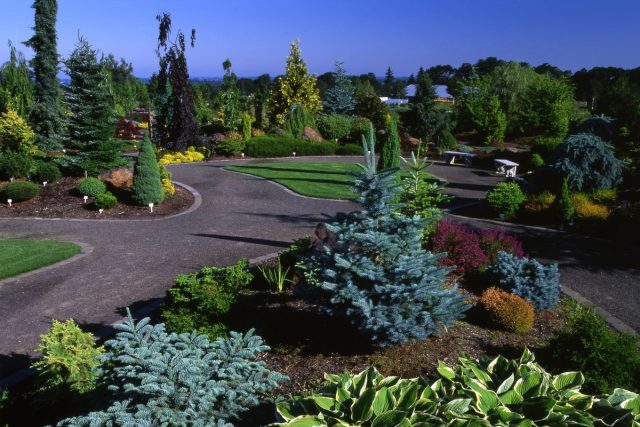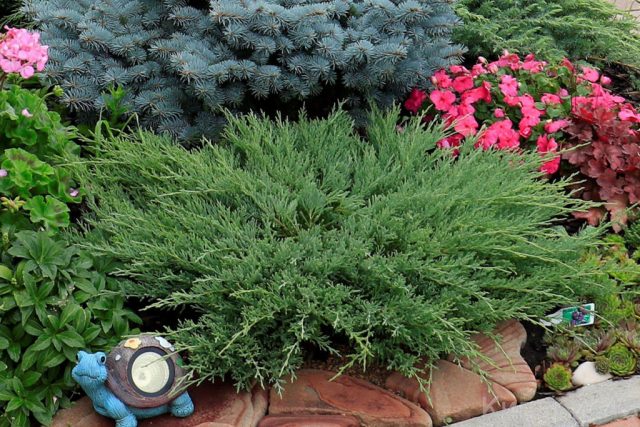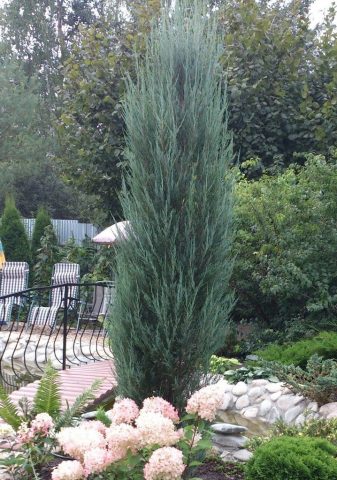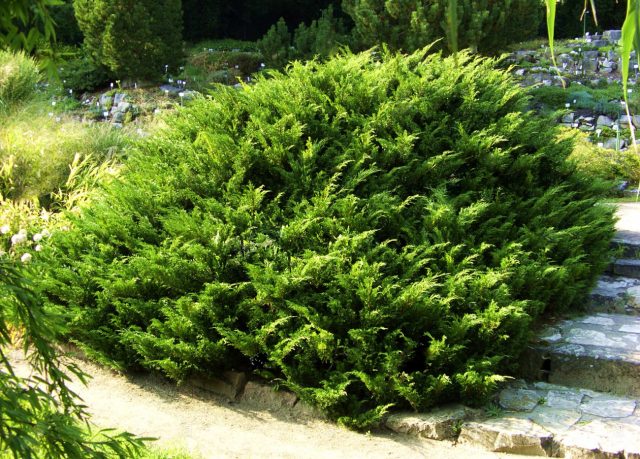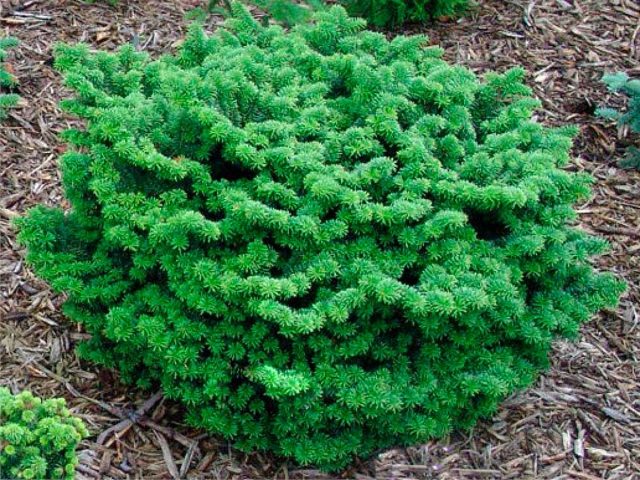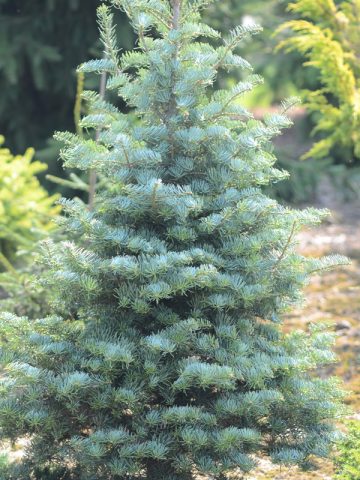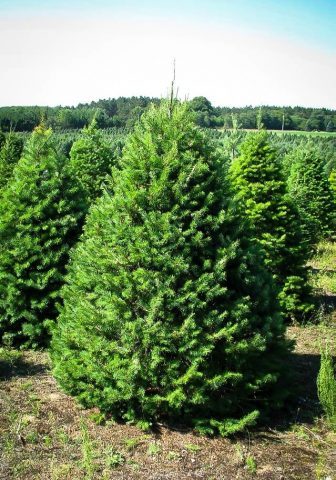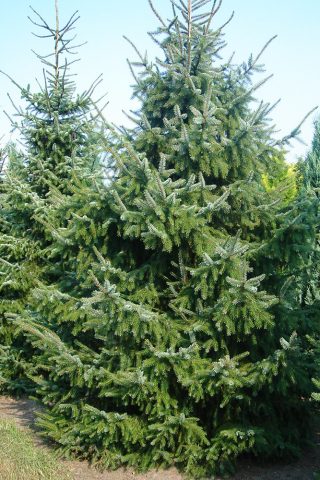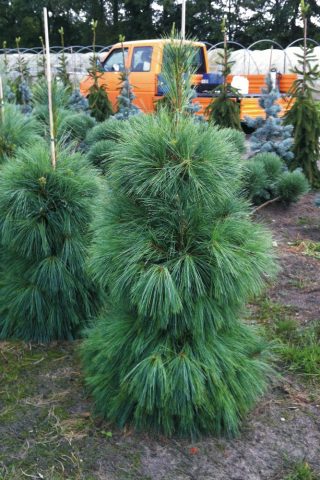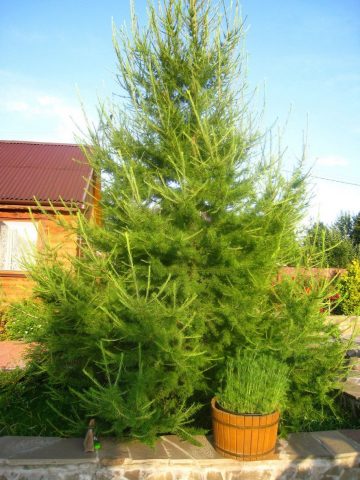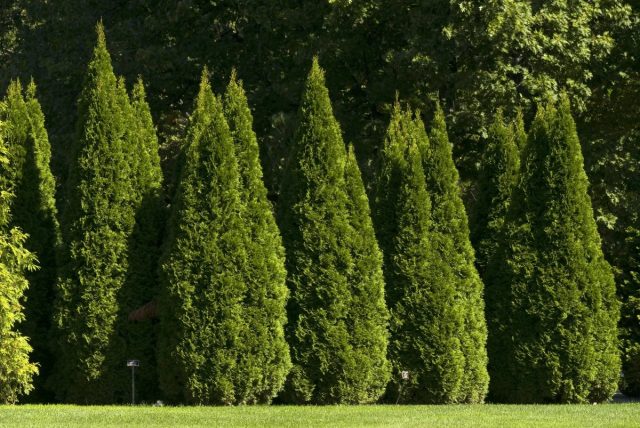Content
Landscaping is the main direction in design techniques. Along with flowering crops, evergreens are planted, which give the garden a decorative look throughout the year. In order for the landscape design to acquire a complete look in a short time, fast-growing conifers and shrubs are planted.
Benefits of fast growing ephedra
Fast-growing shrubs and trees include plants that in the first two years give a significant increase in the crown, then slow down the growing season. In other crops, growth activity is noted after 4-6 years, they give an increase of no more than 5 cm. Fast-growing seedlings actively gain green mass in the first years, they are given the desired shape, after the middle of the biological cycle they grow slowly and intensive pruning is not needed.
Fast growing conifers include pines, spruces and junipers. The evergreen crown makes them popular for gardening. Non-deciduous trees and shrubs are used as hedges and tapeworms. In the design of a hedge, the fast-growing quality of plants is especially important. In a short time, they are able to protect the territory from the wind, divide the garden zones, and give a complete look to the design.
Fast-growing conifers are mainly represented by hybrid crops. In the wild, the classic varieties give a slight increase. Selected species, along with fast vegetation, are adapted to a specific climate, are resistant to diseases and pests, and do not require special care. Coniferous varieties do not take root well in a new place. Fast-growing representatives take root on the site with practically no loss, this quality also refers to their advantages.
Types and varieties of fast-growing conifers with photos
Not all fast growing varieties can grow everywhere. Each of the varieties requires certain conditions corresponding to their characteristics. The main requirements that are guided when choosing a plant:
- climate features. It is necessary to find out how hardy the coniferous plant is and tolerates high temperatures;
- soil composition. There are varieties that grow on any soil, but most of the conifers prefer a certain composition of the earth;
- attitude to light. This biological feature will help determine the landing site, as well as in which composition it is better to use;
- nuances of agricultural technology: does a fast-growing coniferous culture require feeding, watering and crown formation;
- how the neighborhood of certain plants affects the growth.
The names, descriptions and photos of fast-growing conifers will help with the choice of a culture for a summer residence and a personal plot.
Junipers
In landscape gardening, junipers are widely used; they are represented by various varieties. There are ground cover, undersized shrubs and taller representatives growing in the form of a tree.
Prince of Wales
The Prince of Wales horizontal juniper is one of the brightest representatives of the dwarf culture. Used in design as a ground cover plant.
Characteristic:
- Creeping shoots grow horizontally, reaching a length of up to 1.5 m, a height of 20-25 cm.The needles are green with a silvery tinge, by the fall the crown becomes dark purple. Annual growth is 8-10 cm.
- Frost resistance is high up to -30 0C, does not require shelter for the winter, average drought resistance.
- They are planted near reservoirs in partial shade; sprinkling is required in an open area.
- Unpretentious to the composition of the soil, feels comfortable on saline soil, the composition should be neutral or slightly alkaline. Does not tolerate waterlogging of the root system.
Grows throughout Russia, except for the Far North.
Juniper Virginia Hetz
Juniper Virginia Hetz is a medium-sized shrub, depending on the pruning, it is grown as a tree or shrub:
- Height - 2.5 m, crown volume - up to 3 m, annual growth in height - 23 cm.
- The branches are horizontal, the needles are light blue with a green tint, by autumn it becomes maroon.
- The fast-growing ephedra prefers open areas, is light-loving, and does not lose its decorative effect at low air humidity. Reacts poorly to drafts.
- Frost resistance is high, the root system and shoots are not damaged at -35 0C, only young seedlings are sheltered for the winter.
- It grows only on neutral sandy loam soils with good drainage.
Blue Arrow
Juniper Blue Arrow - a variety of Virginia, grows as a tree with a narrow columnar crown in the form of an arrow.
Mass planting is often used to form a hedge. Description:
- Height - 4.5-5 m, volume - 1.5 m.
- The branches fit tightly to the trunk, the needles are small, dense dark blue.
- The growth is 25 cm in height, the length of the branches increases by 5-6 cm. The main growth is up to 4 years, then sharply decreases.
- Fast-growing ephedra frost-resistant (up to -30 0C), photophilous.
- The variety is drought-resistant, it is planted in an open area.
- Does not tolerate drafts and shaded areas.
Grown in temperate climates and in the South.
Juniper Cossack
The creeping type Cossack juniper is represented by several varieties. The fast-growing ephedra is one of the most unpretentious representatives of the culture.
Variety characteristic:
- It reaches a height of 40 cm.
- The crown is fluffy, dense with a bright green color.
- Grows quickly to the sides, requires constant pruning, annual growth up to 30 cm in width.
- Frost-resistant, at -35 0Shelter for the winter is not required.
- Drought-resistant, photophilous, can grow in partial shade.
- Undemanding to the composition of the soil, a prerequisite - there should be no stagnation of moisture.
Grown everywhere, regardless of climatic conditions.
Fir
The fast-growing representative of the coniferous culture is balsam fir. In its natural environment, it grows up to 25 m. For the design of the garden, dwarf varieties are used, represented by shrubs, the most common variety is balsam fir Nana.
Balsam fir Nana
A spherical shrub grows up to 80 cm. The main growth occurs up to 3 years. Vegetation slows down at a height of 0.5 m. Description:
- the crown is dense, the volume is up to 1.8 m, the needles are small, bright green in color with a pronounced coniferous smell, not prickly;
- cones maroon up to 10 cm long;
- the culture is frost-resistant, no shelter is required for the winter;
- poorly tolerates shade, planted only in open areas;
- perennial plant practically does not take root after transfer;
- heat resistance is average, constant watering is required.
A fast-growing coniferous culture grows only on fertile, well-drained, neutral soils. In a temperate climate, it feels much more comfortable than in the subtropical zone.
Fir monochromatic
A single-colored fir with a dense, regular-conical crown is a tall plant.
The height of an adult tree is up to 50 m. Seasonal growth is 30-40 cm. It is used in design as a tapeworm. Description:
- horizontal branches with raised tops;
- needles are large, flat, dark blue with a lemon scent;
- cones are vertical, purple, length - 11 cm;
- coniferous tree resists wind well, drought-resistant;
- due to late bud formation, it is suitable for growing in regions with cold climates, high frost resistance;
- the culture is light-loving, it is planted in sunny areas;
- does not tolerate waterlogging of the soil, it is not demanding on the composition of the soil.
Douglas Fir
Douglas Fir is a tall, fast-growing coniferous tree reaching a height of 50 m. With a beautiful dense pyramidal crown. There are varieties of blue and dark green fir.
The annual growth is 45 cm, the frost resistance of the coniferous tree is average. It does not tolerate waterlogging of the soil; in lowlands with stagnant water, the plant dies. Photophilous culture does not tolerate shading. Good resistance to wind, drought and air pollution. Unpretentious to the composition of the soil.
Spruce and pine
The fast-growing coniferous representatives of the species include the Serbian spruce. The growth is 50 cm annually.
Serbian spruce
The coniferous tree is tall, the main growth occurs up to 6 years of vegetation. Characteristic:
- the crown is lush, conical;
- the needles are small, dense, pointed at the end, bright green at the base with a white stripe along the edge, it seems that the tree is touched by frost;
- dark purple cones grow down, length - 12 cm;
- the culture is frost-resistant, the needles respond well to direct sunlight;
- placed in an open area;
- low humidity does not affect decorativeness;
- does not tolerate waterlogging of the soil.
Can be grown throughout Russia.
Weymouth Pine
The fastest growing coniferous crop with an unusual decorative crown is the Weymouth pine.
Pine growth is 60 cm per year. General review:
- A perennial coniferous culture grows up to 17 m, the main growth gives up to 4 years.
- The crown is asymmetric, with a poorly defined apex, domed.
- The needles are long - up to 12 cm, wide, growing downward, bluish in spring, closer to green in autumn.
- Frost-resistant, light-loving, loses decorativeness in the shade.
- Prefers loamy, well-drained soils.
Weymouth pine is represented by a variety of varieties that differ in color, shape and height.
European larch
European larch is a fast-growing coniferous plant. Its annual growth is up to 1 m.
A tall, bright coniferous tree with a dense pyramidal crown reaches a height of 20-25 m. Suitable for large backyards and city squares. The tree is deciduous, thin long needles in the spring of a rich green color, by autumn they turn bright yellow. With the onset of frost, larch sheds its needles. The culture is unpretentious in care, soil composition, and place of growth. Frost-resistant, does not react to moisture deficit.
Thuja
Western thuja is also a fast-growing coniferous species. A plant in design is very popular, it is planted as part of a composition, and is often used as a material for a hedge.
Thuja grows rapidly (up to 55 cm per year), responds well to pruning, and has a pleasant smell. Photophilous, drought-resistant coniferous tree grows on all types of soil. Depending on the variety, the crown is pyramidal or oval, tapering at the top.
Which fast-growing conifers are the most unpretentious
The criteria by which the simplicity of fast-growing conifers and shrubs is determined:
- frost resistance - no need to cover for the winter;
- fast restoration of areas damaged by frost;
- drought resistance - the needles are not baked in the sun;
- undemanding to air humidity - the needles do not dry out and do not crumble;
- full vegetation on all types of soil;
- in the rainy season, the crown does not lose its decorative effect.
The unpretentious, fast-growing coniferous representatives of the flora include:
- junipers: Blue Arrow, horizontal Prince of Wales, Cossack;
- fir: balsamic, monochrome, Douglas;
- thuja western;
- Serbian spruce;
- European larch;
- Weymouth pine.
Conclusion
Fast-growing conifers and shrubs are necessary for the landscaping of the site; they allow you to give the design a complete look in a relatively short time. Conifers are unpretentious to care for, most of the species grow on any soil, except for swampy ones. Trees are frost-resistant and heat-resistant, do not require shelter for the winter and constant watering in hot summers.
